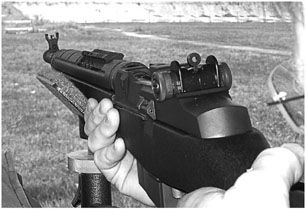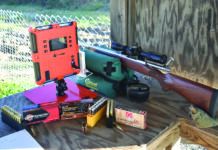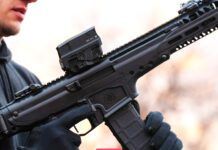
The bulk of our evaluations at Gun Tests consist of head-to-head match-ups of like weaponry. However, every once in a while we come across firearms that occupy such a small niche, that competing products are hard to find. The best that we can do is match them up by job function, and see which product we prefer.
The job this month is long-gun self defense, and our two candidates offer different solutions to problems presented in the survival or tactical arenas. For example, the Kel-Tec SU-16 is, for all intents and purposes, a lightweight AR-15 that folds in half. Our other test sample is less exotic. The Springfield Armory Socom 16 is an M1A carbine that has been fitted with modern upgrades that make it more suitable for close-quarters battle. Although a few custom shops are beginning to offer M1As with similar modifications, the SOCOM 16 is a unique production model.
Despite their differences, our test guns do have some things in common. Each gun is chambered for a widely available, time-tested round. The SOCOM 16 shoots .308 Winchester (7.62 NATO), and the SU-16 is chambered for .223 Remington or, 5.56mm ammunition. Each gun comes equipped with sights consisting of a vertical front blade and aperture rear sight. Each gun comes with a scope mount in place, but adding electronic or other scopes requires either a high mount or removing the rear aperture piece. Both guns employed synthetic stocks, and each gun functioned via gas operation fed from a removable box magazine. Aftermarket magazines of higher capacity are also available. We tested both carbines for accuracy at 50 yards from a rest using only the supplied sights. Here is how they stacked up.
[PDFCAP(1)]
The Kel-Tec SU-16 version of the AR-15 rifle featured a barrel and mechanism composed of 4140 steel, but the remainder of the gun was constructed of DuPont Zytel, or reinforced polymer. The forend could be unlatched, splitting in half to drop down and form a bipod. We found that the amount of support this bipod offered was not rock solid but it was helpful when used in conjunction with additional support. For this reason our accuracy tests were performed with the forend locked into the traditional position. However, when we received the SU-16 we had difficulty locking both halves of the forend into place along the barrel. We were finally able to seat the forend by removing material along the edges where the two pieces met. The magazine release was in the familiar position just ahead of the trigger guard on the right side, but the safety and the charging bolt varied from standard AR-15 design. The safety was a crossbolt assembly mounted above and to the rear of the trigger guard instead of being available to the thumb on the left side of the weapon. The safety was hollow on the right side and capped on the left side. (Safety off required pushing the bolt right to left). The charging mechanism was a simple bar operating just above the magazine well on the right side.
Kel-Tec did a good job of adding grip to the slippery polymer and creating tactile clues for the safe operation of this carbine. The forend, pistol grip area, and the sides of stock toward the butt were textured with useful checkering. The magazine release, however, was left smooth, and we found it to be lost among other nearby raised surfaces. We would have preferred a checkered magazine release to prevent the index finger from slipping off into the trigger guard.
Overall length of the SU-16 measured 37.5 inches with a maximum height of just over 7 inches. Folded for storage, the SU-16 became a package measuring 26.2 inches long and approximately 7.5 inches in height. Weight was 6 pounds with the two supplied polymer magazines stored (empty) in the underside of the stock. The SU-16 will also operate from standard AR-15 magazines. Kel-Tec claims this same storage space is compatible with either a single 20-round or 30-round magazine, but we couldn’t get a 30-round magazine to settle into this compartment. We found that a 20-round magazine could be stowed, but the resulting fit wasn’t ideal.
To fold the SU-16, we removed a single pin in much the same way that disassembly begins for an AR-15. But in this case the pin must be completely removed. Once folded, loss of the pin is prevented by slipping it back into the channel on the top end. A wire retainer mated with grooves in the pin kept it in place. It might be wise to keep an extra pin on hand.
The sights on the SU-16 consisted of an oversize aperture rear sight that was mounted on the Picatinny rail and a hooded front blade that sat about 2 inches above the muzzle. The front sight can be moved left and right to change windage and up or down to effect elevation. The manual provided exact information regarding how much the sight was to be moved versus the resulting change in point of impact. The rear sight can be moved forward or back, resulting in a change of sight radius that would further change elevation. However, in our opinion, the locking pin was seated so tightly into the rail that attempting to remove it would cause irreparable damage to the pin, the sight, the rail or all three. So, we decided to leave it in place and live with the original point of impact, which at 50 yards turned out to be about 10 inches high.
Our [PDFCAP(2)] consisted of 62-grain FMJ rounds from Federal American Eagle and Winchester USA. Our third choice of test ammunition was a remanufactured load by Georgia Arms (770-459-5117) that featured Winchester cases and a 55-grain FMC bullet. Average velocity was topped by the Federal rounds that moved at 2919 fps and produced the most muzzle energy of 1174 foot-pounds. The sights proved to be as clear as they were simple, and we rated the 6-pound trigger as acceptable in terms of feel. Since each of the carbines was designed for high-capacity magazines, we dispensed with the practice of measuring mere three-shot groups. Instead, we fired five-shot groups, just like we would a pistol. Results from a sandbag rest met our expectations for this little folding carbine. We landed the most consistent groups in combination with the Federal American Eagle rounds, with little variation from the average measurement of 2.2 inches per five-shot group. The Georgia Arms rounds, which have scored well in the past with other rifles, managed a 3.0-inch average group, and the five-shot Winchester groups varied from 2.3 to 3.0 inches in size.
To improve this performance and simplify adjusting the point of impact we thought that the best bet would be to simply top the SU-16 with a scope. Our first choice would be the Sightron S33-4R scope, because it offers excellent light and a choice of four different reticles, ($233 from Brownells, 800-741-0015). But, any number of dot scopes would likely be up to the task making the Kel-Tec SU-16 even more appealing.
The only question left in our minds was durability of this folding gun. We opened and closed the SU-16 repeatedly in an attempt to disrupt alignment, and we fired over 250 rounds through it without the benefit of lubrication. So far we have not seen any hint of malfunction.
[PDFCAP(3)]
Springfield Armory of Geneseo, Illinois, is not to be confused with the famed military facility once located in Springfield, Massachusetts. But the Midwestern manufacturer of pistols and rifles has had a lot to do with producing new M1A rifles for those who want a taste of yesteryear.
With the introduction of the SOCOM 16 carbine, the M1A-style rifle chambered for .308 Winchester may carve out a niche for itself among modern tactical weapons. Probably the most significant advancement in the design of this rifle is how rounds feed. The M1 Garand loaded rounds from an eight-round clip. Technicians at the government armory in Springfield adapted a 20-round detachable box magazine with selective fire, semi-auto or full-auto. In 1957 this new and improved rifle was introduced as the M14, and this weapon is still in use today in Iraq.
The Springfield Armory SOCOM 16 in this test brings the .308’s power to a civilian, semi-automatic, compact format. Lauded as a “close quarter battle rifle,” this weapon may have been useful during the infamous Los Angeles shootout, where full auto-wielding bank robbers wearing body armor held off an outgunned police force for an extended period of time. FMJ .308 rounds fired through the SOCOM would have ended that fight a lot faster, we believe.
The Springfield Armory SOCOM 16 was completely black and fitted with a synthetic stock. There were non-swiveling sling attachments front and rear, and the length of pull was a short 13.0 inches. This rifle weighed in at 9 pounds, including a 16.25-inch barrel (thus the name) that was fitted with muzzle brake and what has been described as a retuned gas system. The front sight was a shielded tritium blade by XS and ghost ring aperture rear sight. However, we found the glow from this narrow vertical blade to be weak. Therefore, we would prefer to rely upon a scope with an illuminated reticle. A Picatinny rail for just such purpose was mounted about halfway down the barrel. One steel-bodied 10-round magazine was supplied, and trigger-pull weight was measured to be 6.0 pounds, (the same resistance as was found on the trigger of the Kel-Tec carbine). But we all felt that the SOCOM trigger was far superior throughout its two-stage pull.
The trigger safety was carried over from earlier designs, requiring the shooter to place the finger inside the trigger guard and push it forward to release the safety. Inserting the magazine was similar to loading an M14. But the straight vertical profile of the 10-round magazine made this process a little awkward. You had to begin by angling the forward edge of the magazine into the receiver before pushing it upward into place.
At the range we used the open sights exclusively. For the most part we did not register any great feats of accuracy with the SOCOM 16. Most of our groups showed three tight shots and two others high or low. But it was a blast to shoot. The muzzle brake did a good job of keeping the gun level, allowing us to make follow-up shots much quicker than we would have expected from a .30-caliber rifle. Our most accurate test round proved to be, just as in the case of the SU-16, a Federal ammunition product. This was the Federal Power-Shok Low Recoil 170-grain soft-point round. In comparison to the Winchester and Black Hills ammunition, which yielded an average group of about 2.4 inches, it was as if the Federal round was made for this gun. The Federal catalog number 308LR1 rounds were short and stubby compared to the other rounds and produced the only sub-1-inch group at 50 yards in the test for an average of 1.4 inches per five-shot group overall. However, we should point out that the Winchester and Black Hills munitions moved much faster and were much more powerful. The Black Hills Gold 150-grain Nosler Ballistic Tip rounds produced nearly 2500 foot-pounds of muzzle energy on average, and a couple of our testers preferred this round when standing and shooting offhand. But when comparing groups on target, we couldn’t argue with the results culled from our bench session.
The SOCOM 16 proved to be a powerful rifle. Notwithstanding its weight in comparison to a comparable length AR-15, this new Springfield Armory edition of an old warrior was more maneuverable and friendlier to shoot than past versions we’ve seen of the M1 or M1A rifles. The predecessor to this model turned out to be more expensive to manufacture than expected, and at an MSRP of $1,757, the SOCOM 16 may also cost more than most people are willing to spend. Still, it isn’t out of line with the price of other .308 carbines, and our poll of retailers revealed an average actual sale price of about $1510. Yet the benefits of this rifle are difficult to dismiss.
Gun Tests Recommends
• Kel-Tec SU-16 .223 Remington, $640. Buy It. This “packable” little AR type carbine met or exceeded our expectations. How many folding high-capacity semi-automatic rifles are there anyway? The addition of a red dot scope would likely make this carbine vastly more effective and appealing.
• Springfield Armory SOCOM 16 AA9626 7.62mm/.308 Winchester, $1,727. Our Pick. The consensus was if you can afford it, buy this gun. We realize, however, that the SOCOM’s high price will probably relegate it to your perennial wish list.



























